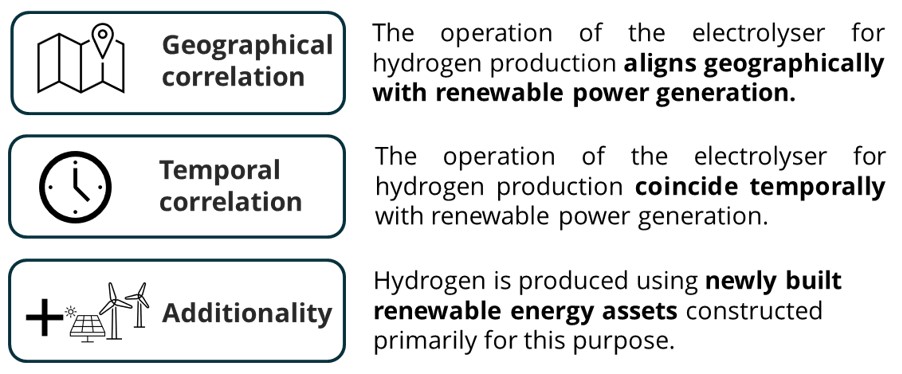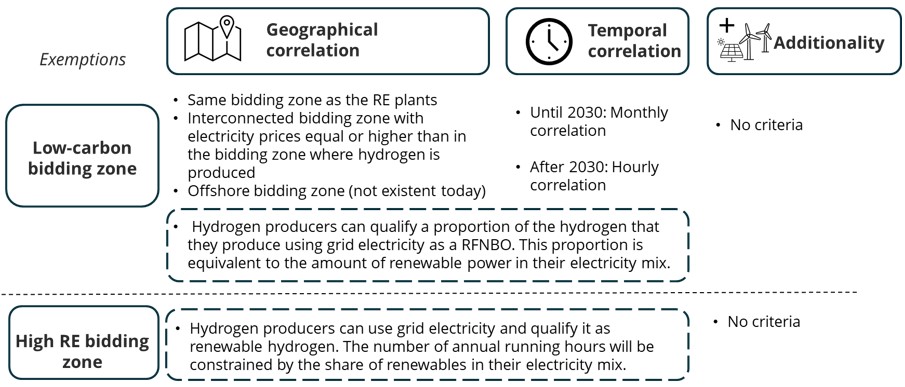The EU’s Renewable Hydrogen Policy Framework
October 30, 2024
These acts focus on defining the conditions under which hydrogen and hydrogen-based fuels can be considered as renewable – renewable fuels of non-biological origin (RFNBO) within the EU terminology1. The vision outlined in this framework is centred on the production of hydrogen through electrolysis, using electricity from renewable energy sources. In this context, the delegated acts specify three criteria to assess whether hydrogen qualifies as RFNBO: temporal correlation, geographical correlation, and additionality.
Figure 1: Key aspects introduced by the RFNBO legislation

Source: Delegated regulation on Union methodology for RFNBOs
The first two criteria are designed to ensure that hydrogen production occurs at times and locations where renewable electricity is available. The additionality criterion is aimed at preventing electrolytic hydrogen production from monopolising existing renewable power capacities. Different cases are described based on the connection type between the electrolyser and the renewable power plant. This connection may involve a direct link to a nearby power plant, referred to as a direct connection, or a virtual connection in which electricity is sourced through renewables power purchase agreements (PPAs). The first table outlines how criteria are applied based on the connection type for the electrolysis plant.
Figure 2: Criteria application for renewable electricity supply according to RED II delegated acts

Source: Enerdata, analysis based on RED II delegated acts
Note: RE: Renewable Energy; PPA: Power Purchase Agreement
The text introduces exemptions where the criteria above do not need to be strictly followed. Two particular instances are highlighted: bidding zones where the share of renewables exceeds 90%, and bidding zones with a carbon intensity of the grid below 18 gCO2eq/MJ or 64.8 gCO2eq/kWh. The second table elaborates on these specific bidding zones, where the criteria are less stringent.
Figure 3: Specific criteria in RED II delegated acts for two exceptions

Source: Enerdata, analysis based on RED II delegated acts
Note: RE: Renewable Energy; PPA: Power Purchase Agreement
The information provided in the second table highlights two significant advantages for these specific bidding zones. Firstly, there is no obligation to develop additional capacities dedicated solely to hydrogen production. The absence of an additionality requirement allows them to leverage existing renewable capacity, whether subsidised or not. Additionally, there is the flexibility to utilise either partially or entirely grid electricity to source renewable energy. It allows electrolysers to operate using grid electricity without the need for a power purchase agreement (PPA), thereby increasing utilisation rates. These areas are favoured for project development, as they entail fewer constraints in securing electricity supply, facilitating the production of hydrogen that meets RFNBO criteria. Consequently, project developers can produce renewable hydrogen (RFNBO) without the necessity to co-develop or secure contracts for new renewable power capacities. The map below highlights the bidding zones that fall under the scope of one of these two cases in 2023.
Figure 4: Map of carbon-intensity and renewable share of electricity in 2023 in Europe.

Source: Electricity map
Note: The coefficients used by Electricity Maps are not necessarily those used by the States. Detailed methodology can be found in Annex C of Regulation (EU) 2023/1185.
RE: Renewable Energy; LC: Low Carbon
One country that stands out on this map is Sweden, divided into four distinct bidding zones. All four fall into one of the two specific cases outlined below, with the two northern zones meeting the requirement of over 90% renewables share, while the two southern zones have a grid carbon intensity below the required threshold. The bidding zone of France also meets the criterion of low carbon intensity.
Search
RECENT PRESS RELEASES
Related Post



